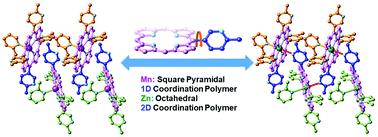当前位置:
X-MOL 学术
›
Dalton Trans.
›
论文详情
Our official English website, www.x-mol.net, welcomes your
feedback! (Note: you will need to create a separate account there.)
Similarities and differences between Mn(II) and Zn(II) coordination polymers supported by porphyrin-based ligands: synthesis, structures and nonlinear optical properties.
Dalton Transactions ( IF 3.5 ) Pub Date : 2020-08-24 , DOI: 10.1039/d0dt02450c Bo-Wei Xu 1 , Ru-Jie Niu 1 , Quan Liu 2 , Jun-Yi Yang 3 , Wen-Hua Zhang 1 , David J Young 4
Dalton Transactions ( IF 3.5 ) Pub Date : 2020-08-24 , DOI: 10.1039/d0dt02450c Bo-Wei Xu 1 , Ru-Jie Niu 1 , Quan Liu 2 , Jun-Yi Yang 3 , Wen-Hua Zhang 1 , David J Young 4
Affiliation

|
Four coordination polymers (CPs) Mn-TMPP (1), Zn-TMPP (2), Mn-THPP (3), and Zn-THPP (4) have been synthesized and characterized (H2TMPP = meso-tetrakis (6-methylpyridin-3-yl) porphyrin; H2THPP = meso-tetrakis (6-(hydroxymethyl) pyridin-3-yl) porphyrin). The one-dimensional (1D) chain compound 1 is formed via a head-to-tail connection of the Mn-TMPP unit, wherein the central Mn2+ features a square pyramidal geometry coordinated by four N atoms from the porphyrin skeleton and one additional N atom from an adjacent Mn-TMPP unit. Compound 2 features an octahedral Zn2+ center associated with four N atoms from the porphyrin skeleton to define the equatorial plane and two additional N donors at the axial positions to give a two-dimensional (2D) CP. The 1D chain of 1 and the 2D layer of 2 possess distinctive molecular structures but nearly identical molecular arrangements in their unit cells viewed along all three crystallographic axes. By contrast, Mn- and Zn-based CPs 3 and 4 supported by the THPP ligand share both identical molecular connectivities and crystal packing. In 3/4, each Mn/Zn center is chelated by four N donors of the porphyrin interior to define the equatorial plane of an octahedron, whose axial sites are occupied by two alcoholic OH groups from a pair of trans-located pyridinemethanol moieties. The third-order nonlinear optical properties of 1–4 investigated using the Z-scan technique at 532 nm revealed reverse saturable absorption and self-focusing effects for all four CPs, with hyperpolarizability values (γ) in the range 1.42 × 10−28 esu to 7.64 × 10−28 esu. These high γ values are comparable to the best porphyrin-based molecular assemblies, demonstrating potential for these materials in optical limiting applications.
中文翻译:

卟啉基配体支持的Mn(II)和Zn(II)配位聚合物之间的异同:合成,结构和非线性光学性质。
合成并表征了四种配位聚合物(CP)Mn-TMPP(1),Zn-TMPP(2),Mn-THPP(3)和Zn-THPP(4)(H 2 TMPP = meso -tetrakis(6-甲基吡啶-3-基卟啉; H 2 THPP =内消旋四(6-(羟甲基)吡啶-3-基)卟啉。一维(1D)链状化合物1是通过Mn-TMPP单元的头尾连接形成的,其中中心Mn 2+具有正方形的金字塔形几何结构,该结构由来自卟啉骨架的四个N原子和一个附加的来自相邻的Mn-TMPP单元的N原子。化合物2其特征是一个八面体Zn 2+中心,该中心与来自卟啉骨架的四个N原子相关联以定义赤道平面,并在轴向位置处具有两个附加的N供体以提供二维(2D)CP。从所有三个晶体学轴上看,1的1D链和2的2D层具有独特的分子结构,但它们的晶胞中的分子排列几乎相同。相比之下,由THPP配体支撑的基于Mn和Zn的CP 3和4具有相同的分子连接性和晶体堆积。在3 / 4,每个Mn / Zn中心被卟啉内部的四个N供体螯合,以定义八面体的赤道面,其八面体的轴向位点被一对转位的吡啶甲醇部分中的两个醇羟基占据。使用Z扫描技术在532 nm处研究的1-4的三阶非线性光学性质显示了所有四个CP的反向饱和吸收和自聚焦效应,超极化率值(γ)在1.42×10 -28 esu范围内至7.64×10 -28 esu。这些高γ 该值可与基于卟啉的最佳分子组装相媲美,证明了这些材料在光学限制应用中的潜力。
更新日期:2020-09-22
中文翻译:

卟啉基配体支持的Mn(II)和Zn(II)配位聚合物之间的异同:合成,结构和非线性光学性质。
合成并表征了四种配位聚合物(CP)Mn-TMPP(1),Zn-TMPP(2),Mn-THPP(3)和Zn-THPP(4)(H 2 TMPP = meso -tetrakis(6-甲基吡啶-3-基卟啉; H 2 THPP =内消旋四(6-(羟甲基)吡啶-3-基)卟啉。一维(1D)链状化合物1是通过Mn-TMPP单元的头尾连接形成的,其中中心Mn 2+具有正方形的金字塔形几何结构,该结构由来自卟啉骨架的四个N原子和一个附加的来自相邻的Mn-TMPP单元的N原子。化合物2其特征是一个八面体Zn 2+中心,该中心与来自卟啉骨架的四个N原子相关联以定义赤道平面,并在轴向位置处具有两个附加的N供体以提供二维(2D)CP。从所有三个晶体学轴上看,1的1D链和2的2D层具有独特的分子结构,但它们的晶胞中的分子排列几乎相同。相比之下,由THPP配体支撑的基于Mn和Zn的CP 3和4具有相同的分子连接性和晶体堆积。在3 / 4,每个Mn / Zn中心被卟啉内部的四个N供体螯合,以定义八面体的赤道面,其八面体的轴向位点被一对转位的吡啶甲醇部分中的两个醇羟基占据。使用Z扫描技术在532 nm处研究的1-4的三阶非线性光学性质显示了所有四个CP的反向饱和吸收和自聚焦效应,超极化率值(γ)在1.42×10 -28 esu范围内至7.64×10 -28 esu。这些高γ 该值可与基于卟啉的最佳分子组装相媲美,证明了这些材料在光学限制应用中的潜力。











































 京公网安备 11010802027423号
京公网安备 11010802027423号